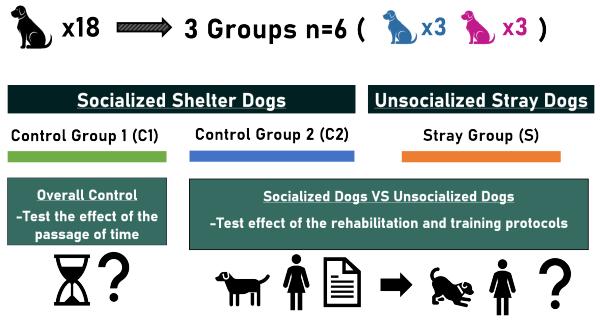Methodology
A total of 18 dogs housed in a municipal shelter in Portugal were selected to be subjects for this study. The selected animals were divided into three groups of six animals each: two control groups and one experimental group (Figure 2). The control groups, hereafter Control Group 1 (C1) and Control Group 2 (C2) comprised six socialized adult dogs, each with three males and three females. Two control groups were needed to compare two distinct conditions, one being the effect of time passage in the dog’s sociability with humans (C1) and other the efficacy of the constructed protocols themselves (C2). These dogs were either collected from the streets of the metropolitan area of Porto, relinquished by their owners or apprehended due to legal justice cases. The experimental group, hereafter Stray Group, consisted of six unsocialized stray adult dogs (three males and three females).

Experimental Design
Initially, the subject’s general behaviour was assessed three-time points before any intervention, this was done at the beginning of the project (GB1), after the implementation of the social rehabilitation protocol (GB2) and after the implementation of the leash training protocol (GB3).
The sociability test was performed on all subjects in a total of six times at three time-points: twice before any intervention (ST1), twice following 40 days of sociability training (ST2) and twice following 40 days of leash training (ST3). At each time-point the test was performed by a ‘familiar’ person – the person who performed the social rehabilitation and leash training, and again by an unfamiliar person – one of the study’s supervisors, with a minimum of a 60-minute interval between the two tests. The leash test was also performed on all subjects in a total of four times at two time-points: twice before (LT1) and twice after the leash training protocol (LT2). At each time-point, the test was performed once with the familiar person and again with the unfamiliar person (minimum of a 60-minute interval between the two tests).
The social rehabilitation and leash training protocols each lasted for 40 days and were only applied by the familiar person to the Stray Group and Group C2. The overall experimental procedure is summarized in Figure 4.

Responsible for this page:
Director of undergraduate studies Biology
Last updated:
05/29/20
